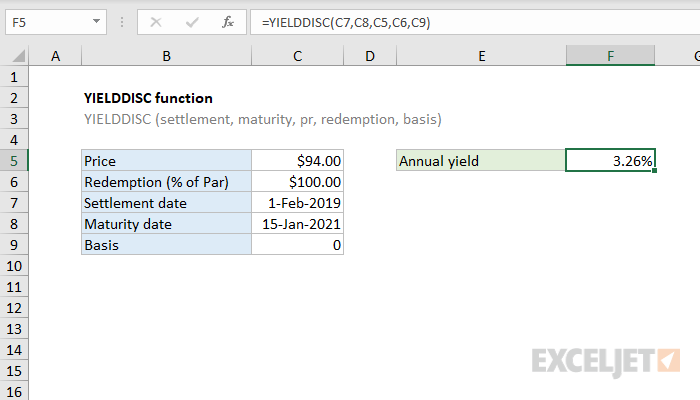Purpose
Return value
Syntax
=YIELDDISC(sd,md,pr,redemption,[basis])- sd - Settlement date of the security.
- md - Maturity date of the security.
- pr - Price of security.
- redemption - Redemption value per $100 face value.
- basis - [optional] Day count basis (see below, default =0).
Using the YIELDDISC function
The Excel YIELDDISC function returns the annual yield for a discounted security (non-interest-bearing), such as a Treasury bill, that is issued at a discount but that matures at face value. In the example shown, the formula in F5 is:
=YIELDDISC(C7,C8,C5,C6,C9)
with these inputs, the YIELDDISC function returns 0.03264023 which, or 3.26% when formatted with the percentage number format.
Entering dates
In Excel, dates are serial numbers. Generally, the best way to enter valid dates is to use cell references, as shown in the example. If you want to enter valid dates directly inside a function, the DATE function is the best approach.
Basis
The basis argument controls how days are counted. The PRICE function allows 5 options (0-4) and defaults to zero, which specifies US 30/360 basis. This article on Wikipedia provides a detailed explanation of available conventions.
| Basis | Day count |
|---|---|
| 0 or omitted | US (NASD) 30/360 |
| 1 | Actual/actual |
| 2 | Actual/360 |
| 3 | Actual/365 |
| 4 | European 30/360 |
Notes
- In Excel, dates are serial numbers.
- Settlement, maturity issue, and basis are truncated to integers
- If settlement or maturity dates are not valid, YIELDDISC returns #VALUE!
- YIELDDISC returns #NUM! if any of the following are true:
- pr <= 0
- settlement >= maturity
- Basis is not 0-4












